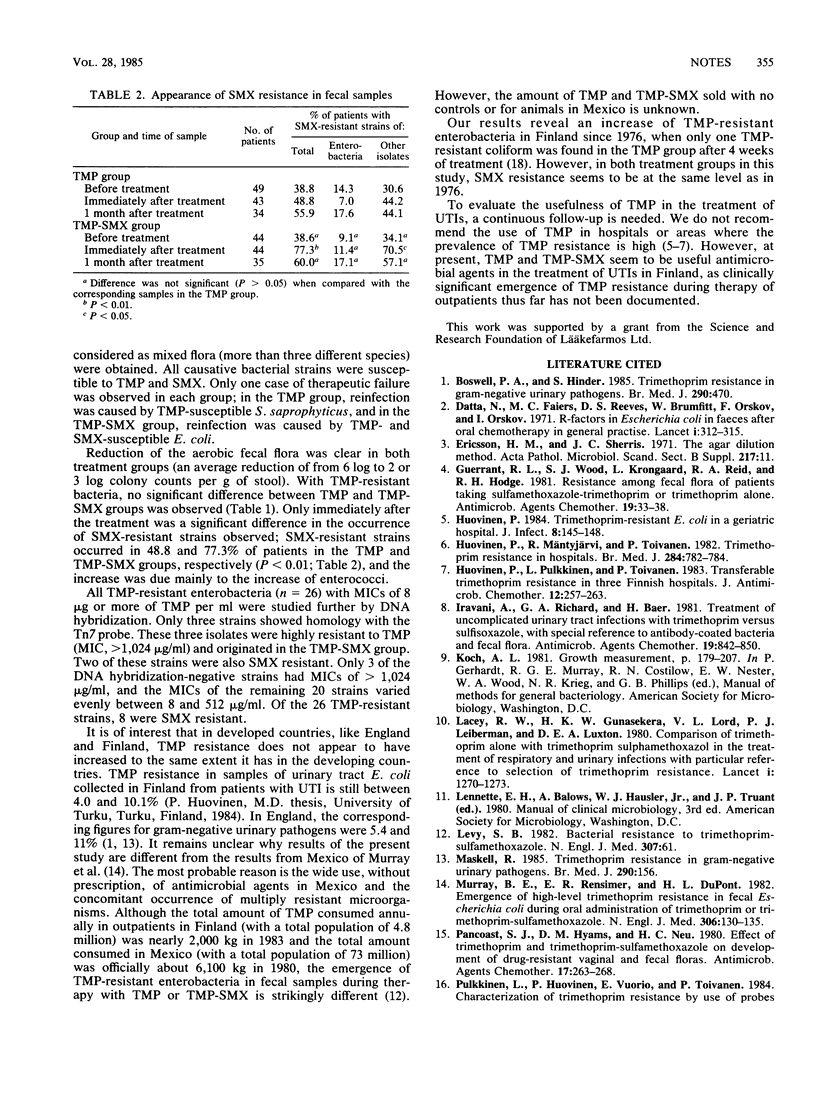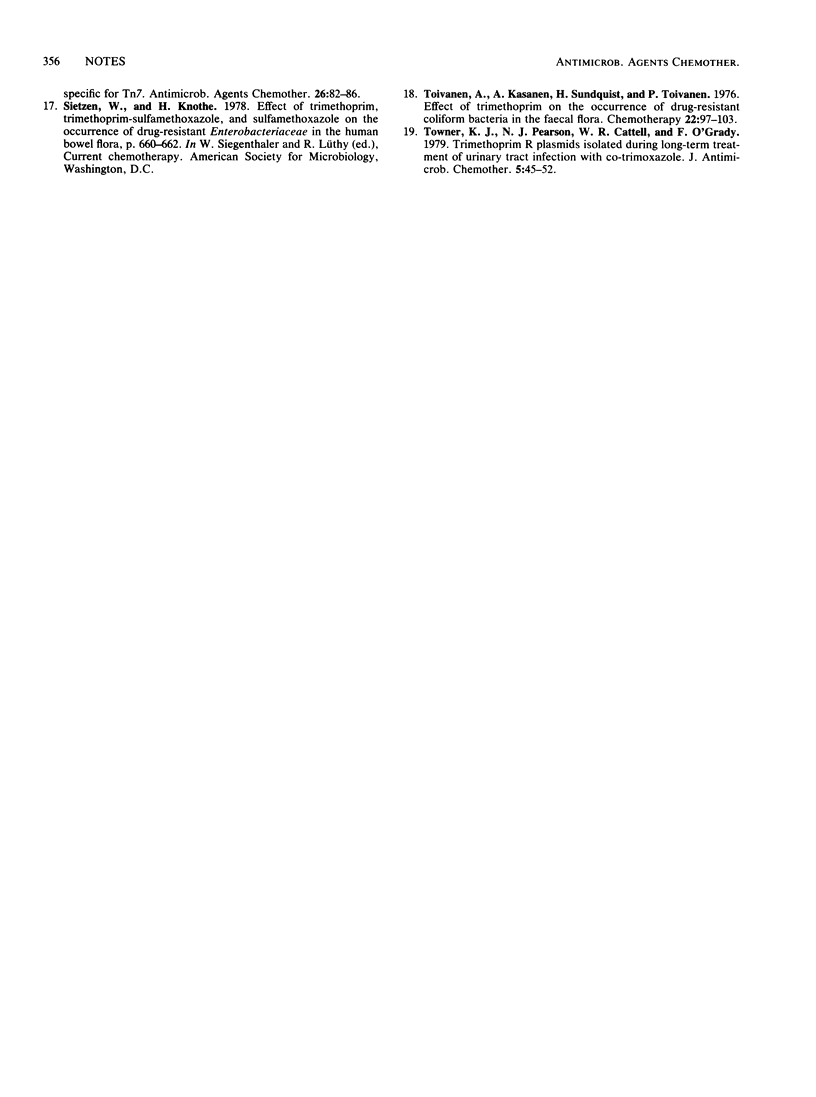Abstract
The emergence of trimethoprim (TMP) resistance in fecal flora was compared in patients with urinary tract infection treated with TMP or TMP-sulfamethoxazole. No significant differences were found in the occurrence of TMP-resistant fecal aerobic bacteria in the two treatment groups before and after treatment.
Full text
PDF


Selected References
These references are in PubMed. This may not be the complete list of references from this article.
- Datta N., Faiers M. C., Reeves D. S., Brumfitt W., Orskov F., Orskov I. R Factors in Escherichia coli in faeces after oral chemotherapy in general practice. Lancet. 1971 Feb 13;1(7694):312–315. doi: 10.1016/s0140-6736(71)91042-7. [DOI] [PubMed] [Google Scholar]
- Guerrant R. L., Wood S. J., Krongaard L., Reid R. A., Hodge R. H. Resistance among fecal flora of patients taking sulfamethoxazole-trimethoprim or trimethoprim alone. Antimicrob Agents Chemother. 1981 Jan;19(1):33–38. doi: 10.1128/aac.19.1.33. [DOI] [PMC free article] [PubMed] [Google Scholar]
- Guinet R. M., Mazoyer M. A. Laser nephelometric semi-automated system for rapid bacterial susceptibility testing. J Antimicrob Chemother. 1983 Sep;12(3):257–263. doi: 10.1093/jac/12.3.257. [DOI] [PubMed] [Google Scholar]
- Huovinen P., Mäntyjärvi R., Toivanen P. Trimethoprim resistance in hospitals. Br Med J (Clin Res Ed) 1982 Mar 13;284(6318):782–784. doi: 10.1136/bmj.284.6318.782. [DOI] [PMC free article] [PubMed] [Google Scholar]
- Huovinen P. Trimethoprim-resistant Escherichia coli in a geriatric hospital. J Infect. 1984 Mar;8(2):145–148. doi: 10.1016/s0163-4453(84)92530-1. [DOI] [PubMed] [Google Scholar]
- Iravani A., Richard G. A., Baer H. Treatment of uncomplicated urinary tract infections with trimethoprim versus sulfisoxazole, with special reference to antibody-coated bacteria and fecal flora. Antimicrob Agents Chemother. 1981 May;19(5):842–850. doi: 10.1128/aac.19.5.842. [DOI] [PMC free article] [PubMed] [Google Scholar]
- Lacey R. W., Lord V. L., Gunasekera H. K., Leiberman P. J., Luxton D. E. Comparison of trimethoprim alone with trimethoprim sulphamethoxazole in the treatment of respiratory and urinary infections with particular reference to selection of trimethoprim resistance. Lancet. 1980 Jun 14;1(8181):1270–1273. doi: 10.1016/s0140-6736(80)91732-8. [DOI] [PubMed] [Google Scholar]
- Maskell R. Trimethoprim resistance in Gram negative urinary pathogens. Br Med J (Clin Res Ed) 1985 Jan 12;290(6462):156–156. doi: 10.1136/bmj.290.6462.156. [DOI] [PMC free article] [PubMed] [Google Scholar]
- Murray B. E., Rensimer E. R., DuPont H. L. Emergence of high-level trimethoprim resistance in fecal Escherichia coli during oral administration of trimethoprim or trimethoprim--sulfamethoxazole. N Engl J Med. 1982 Jan 21;306(3):130–135. doi: 10.1056/NEJM198201213060302. [DOI] [PubMed] [Google Scholar]
- Pancoast S. J., Hyams D. M., Neu H. C. Effect of trimethoprim and trimethoprim-sulfamethoxazole on development of drug-resistant vaginal and fecal floras. Antimicrob Agents Chemother. 1980 Feb;17(2):263–268. doi: 10.1128/aac.17.2.263. [DOI] [PMC free article] [PubMed] [Google Scholar]
- Toivanen A., Kasan A., Sundquist H., Toivanen P. Effect of trimethoprim on the occurrence of drug-resistant coliform bacteria in the faecal flora. Chemotherapy. 1976;22(2):97–103. doi: 10.1159/000221918. [DOI] [PubMed] [Google Scholar]
- Towner K. J., Pearson N. J., Cattell W. R., O'Grady F. Trimethoprim R plasmids isolated during long-term treatment of urinary tract infection with co-trimoxazole. J Antimicrob Chemother. 1979 Jan;5(1):45–52. doi: 10.1093/jac/5.1.45. [DOI] [PubMed] [Google Scholar]


